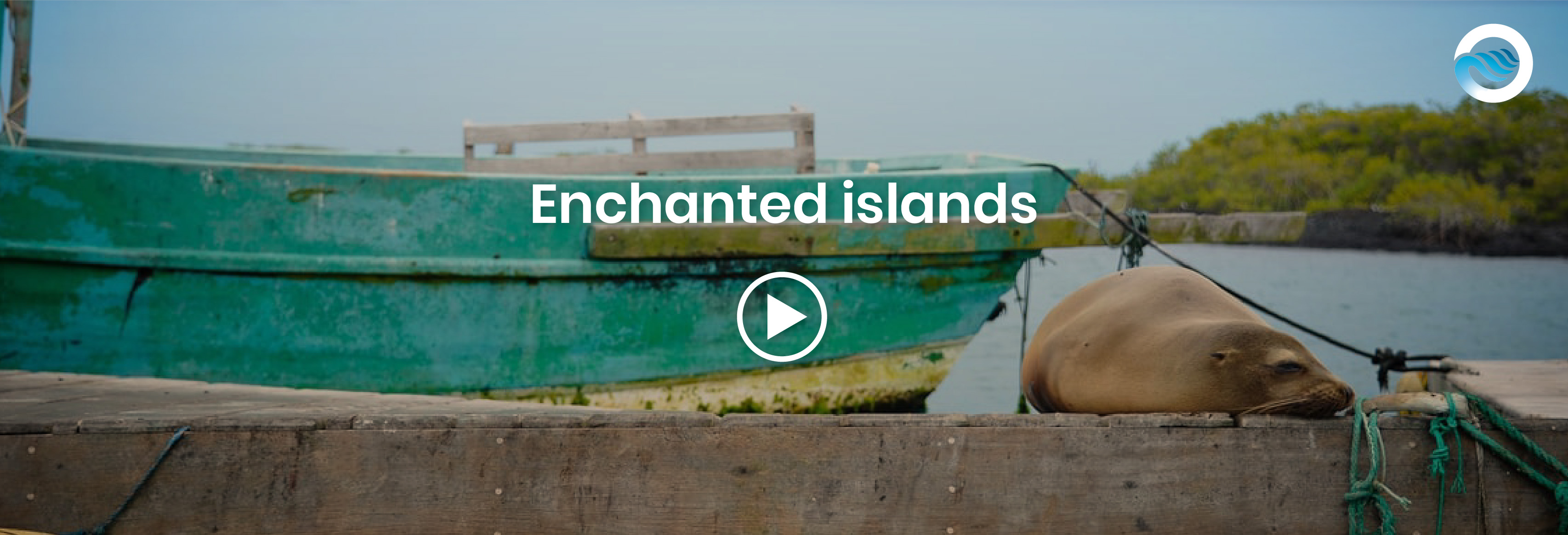+(593)9 8469 5400 enquiries@oniriccruises.com
For 20 million years or longer, a volcanically active hotspot located under the eastern Pacific Ocean (906 km/563 mi west of the Ecuadorian coast) has been bursting magma upwards through the crust, giving rise to the Galapagos Islands.
The eastern islands are generally older, while western islands have emerged more recently (in geological timescale). This distribution, combined with the large distances separating the islands from any other land, and the unique convergence of the cold Humboldt, Cromwell, and warmer Panama oceanic currents, created a very special place that has allowed its species to evolve in singular ways.
These factors, along with the creation of the Galapagos National Park and Galapagos Marine Reserve, are the main reasons why these, dubbed the Enchanted Islands, are such a special place where travellers can discover life-changing experiences.
The overall climate on the Galapagos Islands is very pleasant without any drastic changes in temperature over the year. However, we can speak of two seasons:
The cold/dry season, lasting from late June to November has temperatures ranging between 21 to 26 ºC / 69 to 78 ºF.
The hot/wet season, lasting from December to April has temperatures ranging between 24 to 31 ºC / 75 to 87 ºF.
The best time to visit Galapagos Islands depends on your own preferences.
During the cold/dry season, the antarctic Humboldt Current brings rich nutrients to the waters around the islands and, with that, an increased food supply. As a result, marine life is most active and abundant, bringing whale sharks and optimal breeding conditions for sea birds, marine iguanas, and sea lions. Snorkelling and diving adventures are especially rewarding in this period.
In the hot/wet season, the Humboldt Current loses strength, reduces plankton’s upwelling, and allows for warmer water from the Panama Current to flow past the Galapagos Islands. As a result, ocean temperatures rise. Onshore, the arid lands bloom, with overwhelming new vegetation providing shelter for endemic and migratory birds. Green sea turtles can be also seen around shores waiting to lay their eggs.
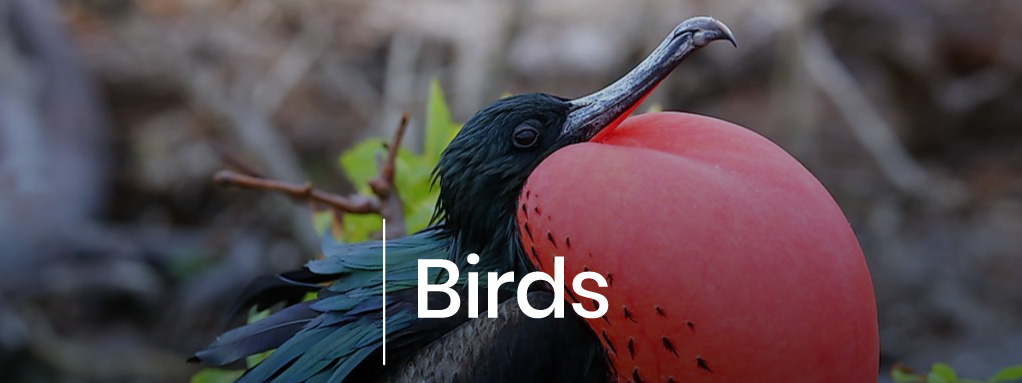
The birds of Galapagos defy the conventional wisdom that humans have about this species. Some of them thrive in the water instead of the air, like the Boobies, who are amazing swimmers. Others are almost purely land-based, like the Flightless Cormorants who are confined to shorelines and beaches. And even the expected aerial birds like the Frigates, have unbelievable and unparalleled flying habits, being able to spend more than one week in the air without landing! Keep reading to find interesting facts that will spark your curiosity about the birds of the Galapagos.

All boobies are expert plunge divers that can reach speeds of 90 km/h (56 mph) before touching the water and can swim to depths of 25 m/82 ft in pursuit of their prey. They have special adaptations for these extreme hunting methods: their skulls have special air sacs that protect the brain from large pressures and sudden decelerations, and eyes and nostrils that have adapted to avoid high-pressure water from entering during these swift attacks.
They mostly feed on schooling fish like sardines, anchovies, and mackerels. When the lead bird spots a shoal in the water, it signals the rest of the group and they all execute simultaneous dives. Their sharp beak and arrow-like shape when diving is what gave them the Spanish name of Piquero (pikemen, in English). The other Spanish name, pájaro bobo (silly bird), comes from its funny face, clumsiness on the ground, and adorable courtship dances.
In male red-footed and blue-footed boobies, the brightness of the foot colour marks them as less or more desired individuals to females. Brighter feet tend to indicate higher fertility and the ability to provide paternal care over other males, thus rating them as more suitable. Another interesting fact about all these birds is that they use their webbed feet, along with the heat from their breasts, to incubate the eggs.

Of the 5 different species of Frigatebirds in the world, 2 live in the Galapagos: the Great and the Magnificent. The latter is considered endemic to this archipelago and is the largest of the 5. Actually, compared to their body size, their wingspan is considered the largest in the animal kingdom (up to 2.50 m/8.20 feet while open). The females are black with a white breast and shoulder, while the male is all black with a purple sheen.
The most distinctive physical feature of this bird is the red pouch that males have on their throats, and inflate during the breeding season to attract females. The males sit together as in a social gathering and compete for who has the largest pouch, which is intimidating for their peers and attractive for their mates. After this ritual, they become excellent parents. Laying only one egg, when it hatches, the father cares for the chick for the first 3 months and the mother for a further 9 months. The longest parental care in the bird world.
Worth mentioning is that Charles Darwin called these ‘Pirate Birds’ because he observed their habit of stealing food from other birds, and because of their long absences from land. On the first point, Frigates chase blue-footed boobies until the point of intimidation, making them vomit so they can steal and feed off the latter’s last meal. On the second point, they use their enormous wings to navigate air currents for long periods of time without eating or touching land. Truly magnificent!

The first person who observed a Penguin at the Galapagos islands must have thought of it as a surreal sight. Through millions of years, these birds have evolved anatomical characteristics to live in the cold, and life in warm climates would make their survival impossible. The reason why it is feasible for Galapagos to have its own Penguin is the presence of the Humboldt Current.
This is an oceanic current that flows at approximately 16 °or 61 °F (very low compared to the ‘normal’ 25 °C or 77 °F in other regions) that brings nutrients that allow Penguins to thrive in the very tropical Galapagos islands. Sadly, they are considered to be in danger of extinction, because of their high sensitivity to the impacts of climate change, as well as of plastic pollution.
You can help to protect the fragile population of the Galapagos Penguin (below 2000 birds) by donating to the Galapagos Conservation Trust’s program Adopt a Penguin.

If you think of birds as extraordinary creatures and you feel enraptured by their sight (like we do), you should plan your visit to the Galapagos so you don’t miss the show put on by the Albatross. They are large, fluffy birds with enormous wings, creamy-white heads, and chestnut brown bodies. From April to June, they engage in one of the most beautiful courtship rituals among birds.
Their performance includes bill circling, bill clacking, head nodding, a waddle, and even sounds that resemble a cow’s moo. This elaborate dance marks the occasion when two birds will unite as a monogamous couple for the rest of their lives. You can observe this ritual in Punta Suarez, on Española Island.
This is a rocky plateau, eroded by millions of years of harsh winds and storms, where Albatrosses establish their organized communities. Each couple selects a solid and clear ground to lay the egg and make it roll over to improve hatching success. The juveniles attend the cliffs of the island to learn to fly by jumping into the abysm. And the chicks are organized in nurseries where they will safely remain while the adults are away at sea.
Organize your trip to Española island bearing in mind that from December to April, they massively leave Española island towards the inaccessible eastern seas of Galapagos, where they will sit above the water feeding on squids and surface fisheries until the next breeding season.

This is one of the animals that likely induced Charles Darwin to consider (and develop) his theory of the evolution of the fittest. When the Flightless Cormorant first arrived at the Galapagos, it had functional wings for the same reasons all birds do: to escape predators and to travel to find better sources of food.
These survival priorities changed about 2 million years ago when this bird arrived at the insulated lava shorelines of the Galapagos. First, it encountered zero land predators, so it gradually lost the motivation to fly for escape. And second, it soon learned that the seas below its feet provided the most stable and secure food source.
The best swimmers among the Cormorants were the best fed, and consequently the most successful in passing their genes to the next generation. And this is how the Flightless Cormorant was originated. Its wings lost the ability to fly but became powerful underwater propellers. The birds’ lifecycle became so intermingled with water, that even its mating ritual happens at sea. Male and female swim with their necks intertwined, twirling in a circular dance. Next, they walk to the shore and build a nest together where they’ll lay their eggs.
If you want to marvel at this proof of natural selection, plan a visit with us to the Isabela and Fernandina islands, the exclusive dwellings of the Flightless Cormorant.

Of the 15 species of Finch present in the Galapagos, 13 are considered endemic, and they all descend from one ancestral species. What is astonishing to scientists, is that each one of these developed unique morphologies that enabled them to be simultaneously competitive. For example, the ground finch developed a thick beak adapted to feeding on hard seeds and robust arthropods, while the warbler finch developed a slender bill perfect for catching other types of elusive insects that hide between the foliage. The woodpecker finch even learned to use cactus spines as a tool for prying small animals out of tree holes. This disconcerting specificity of adaptation has enabled the parallel success of various species, and even the apparition of new ones up to our days.
Also notably, each species of Finch has its own song. Sadly, one of these is at risk of going mute forever. The Mangrove Finch has gone extinct across much of its range, and only a population of 100 birds remain on the northwest coast of Isabela Island. Threatened by habitat destruction and predation by rats, their recovery has been very difficult. You can help the conservation efforts by donating to the Mangrove Finch Project, run by the Galapagos Conservation Trust.
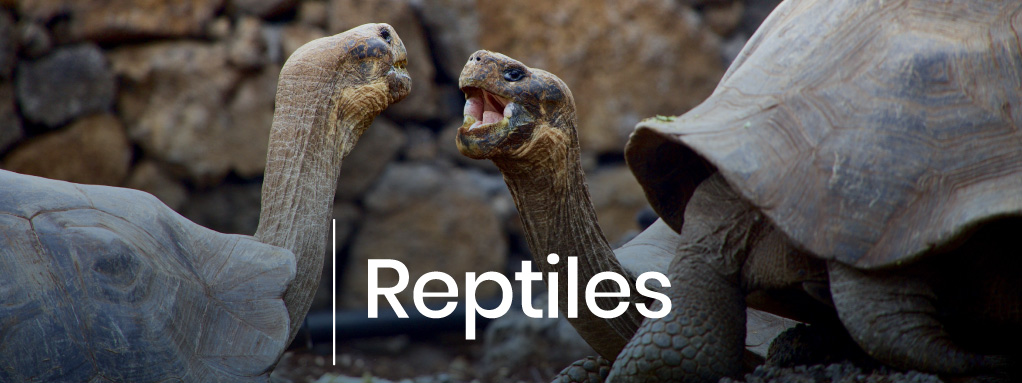
Before the massive extinction events in the Cretaceous and Mesozoic periods decimated the earth’s reptiles, they were the most frequent species to be found. The Galapagos Islands are one of the most remarkable sites to find those who survived, except for crocodiles. Keep reading to learn about the reptile species that make the Galapagos islands resemble a prehistoric ecosystem.

The Galapagos green sea turtle is a frequent and captivating sight when you’re swimming at the Galapagos Sea. They are soft paced, have enthralling geometric patterns and colors, and are crucial for the health of seagrass ecosystems. You could say that green sea turtles are the landscapers of the ocean because they carefully graze and trim the tops of marine plants, keeping these floral ecosystems in neat condition.
Their life-cycle is pretty similar to that of humans. They spend 3-10 years in nurseries, become sexually mature at 18, and live on average 80 years. Sadly, their reproduction efforts are increasingly difficult. The female crawls up the beach at night, digs a nest with her flippers, and lays between 50 and 200 eggs. In the Galapagos, they are safe from being dug up by humans (unlike in many beaches around the world), but cormorants, albatrosses, gulls, crabs, and even introduced rats, wait for the hatchlings and consume most before they even reach the sea. This is why only a few of them finally reach the ocean, and even there, they face a battle to survive.
The ones that do make it, are some of the most captivating creatures that can be seen on coastal waters. If you snorkel in the Galapagos, there’s a high chance you might come across one. Try not to move too fast, as that could scare them. They often make eye contact first, examine if you are not a threat, give you time to enjoy their gorgeous features, to finally continue their peaceful journey towards the blue horizon.

How did such a massive animal (660lb), originally from the Amazon, end up at the Galapagos islands, 1000 km away?
One theory is that millions of years ago, heavy rains on the Amazon caused vegetation to collapse and form floating debris, where tortoises stepped over to survive. These structures got transported by rivers towards the ocean, and after a long time, some arrived at the Galapagos.
Upon their arrival, tortoises were very successful, populating 7 islands, diversifying from 1 to 14 unique species, becoming bigger, surviving volcanic cataclysms, and even baptizing the islands. Yes, you read that well. When Spaniards discovered the archipelago in 1535, they reported to King Charles VI that they had found Galapagos, referring to tortoises. Why? Because Galapago is an old Spanish word for saddle, and tortoise shells look a whole lot like saddles! The name stuck.
For the following centuries, Galapagos became a favorite destination for Pacific pirates, who hunted down tortoises for their meat and oil (used to light lamps). It is estimated that at least 100,000 animals perished, and two species became extinct.
Since 1959 they have been protected and the beneficiaries of exhaustive conservation efforts. Tourists can see these modern-day dinosaurs on the humid highlands of Santa Cruz island, the Alcedo volcano of Isabela, and breeding centers in Puerto Ayora, Puerto Villamil, and Puerto Baquerizo Moreno. Better if you visit them in the early morning or afternoon, as these are the only moments when they are active (they rest 16 hours a day). When awake, they can be seen feeding on grass and fruits, making ferocious sounds, and transporting finches on their backs.

Just like tortoises, Galapagos iguanas have gone through a lot. They were land-dwelling reptiles minding their business in South America until strong climatic events caused some members to drift across the Pacific Ocean to the Galapagos Islands. Then, environmental requirements required some of them to develop marine adaptations, giving birth to a whole new separate species, the marine iguana (which we will cover next).
Together, they colonized the archipelago, and for the following 10 million years, turned Galapagos into the only place on earth dominated by reptiles (just like at the Dinosaur age). Their success came to a halt during the 60s and 70s when feral dogs (recently introduced by humans) virtually devoured entire iguana populations on Isabela and Santa Cruz. Scientists had to remove the remaining iguanas from those sites, breed them in captivity, and later reintroduce them when feral dogs were eradicated. Today all populations appear to be healthy!
There are 3 distinct species: the golden-yellowish Conolophus subcristatus, native to six islands; the brownish Conolophus pallidus, only found in Santa Fe; and the pinkish-purple Conolophus marthae, an endangered variety native to Wolf Volcano in Isabela. All 3 species are large, measuring more than 3 feet (91 cm). They barely approach the water, preferring drier areas, but stay hydrated thanks to their diet of juicy cactuses, crabs, insects, and their own shed skin!

Being cold-blooded, the Galapagos marine iguana spends a lot of time laying flat over the rocks under the blazing sun, in order to absorb as much heat as possible, before venturing into the cold seawater. They dive as deep as 12 meters to find the right algae to feed on, using their evolved flat tails to propel. If marine iguanas cannot find sufficient food for extended periods of time (El Niño climatic events), they will shrink in length and regrow when food becomes plentiful again. A great example of adaptation.
There are seven subspecies of the marine iguana, each having a unique combination of colors including black, red, green, and grey; and can be seen in the coastal regions of Isabela, Fernandina, Floreana, Santa Cruz, and Española. In these places, you could observe them packed one over another on top of black lava rocks, which aid in their camouflage. Their presence is often revealed by their fast head wagging and spitting. With these movements they’re sending you a message – keep your distance!
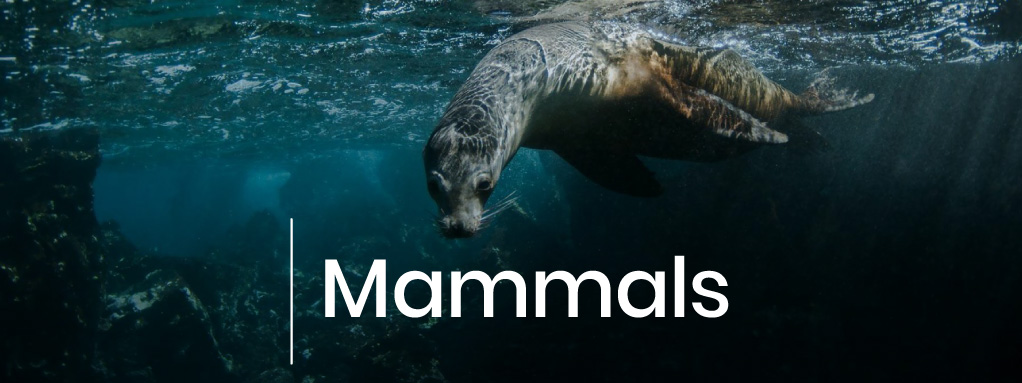
The Galapagos Islands are home to a total of 32 recorded indigenous species of mammals.
Of course, this doesn’t include introduced species (animals that are not native to this area and have been transported accidentally or deliberately, like rats, mice, and pets) or domesticated species that have become wild (like cattle, horses, dogs, cats, and more). These are the most representative mammals:

The Galapagos sea lions are one of the most iconic species of the archipelago. They can be quite large, with a length that can range from 1.50 m/4.9 ft to 2.50 m/8.2 ft, and can weigh up to 250 kilos/550 lb. Regardless of this, they are incredibly agile swimmers that can hold their breath for more than 20 minutes and feed regularly on small fish, squids, and other mollusks. They also eat a lot! An average male can eat 13-20 kg/30-45 lb every day!
Sea lions have physiological differences between genders. The males are much larger than females (two to four times their size) and also develop a large sagittal crest on the skull as they begin puberty. They are sexually active at six years old but continue developing until about ten years old. Males typically live about 18 years due to all the energy expenditure during their reproductive life, while females tend to live up to 24 years old.
Males are also very territorial. When a colony is formed, the alpha male will reproduce and take care of the entire group. These colonies can be very large, with hundreds of individuals. During mating season, males become more territorial and loud and often fight for territory and reproduction. Females have a gestation period of 11 months. They will feed the pup for up to three years, although it will learn to swim and hunt much earlier. Both genders have strong frontal fins that allow them to walk inland and, although they can climb rocks, prefer sandy beaches.

The Galapagos fur seal is the smallest species of the seal family. It is less social than its cousin, the Galapagos sea lion, and also more nocturnal and rarer to see. There are much fewer fur seals than sea lions because they were hunted constantly in the 19th century for their fur. Another interesting difference with sea lions is that they prefer rocks over sandy beaches, and are one of the fluffiest of the seal family!
They are mostly found in the islands of Santiago and Genovesa and feed on squids and small fish. They have very sharp nocturnal hunting techniques and tools, like their big eyes and whiskers. Another difference with sea lions is that females are very territorial creatures, and they will claim an area of the beach to take care of the pup.
Males can have territories that average 200 m2, which is large in comparison with Sealion males. This species also has the lowest reproductive rate in seals, and this issue worsens in times when food is scarce. El Niño effect has a large impact on their populations and affects especially pups that are born with an older sibling that is still suckling.

There are two kinds of whales that pass through the Galapagos: the ones with teeth and the ones that are filter-feeders. The baleen whales are the largest mammals on the planet, and almost all species of rorquals (a subspecies of the baleen whales) have been seen in the Galapagos, including the largest animal to have ever lived: the blue whale! These feed by filtering the water they swallow with their baleen and trapping plankton and krill inside their mouths.
On the other hand, orcas and sperm whales (all members of the dolphins family) feed on fish. They have very interesting and developed hunting techniques and are considered among the smartest animals on Earth.
Almost all of these whales pass through the Galapagos as a part of their long migration routes. They are most often seen during the cold season, occurring from June to November, following the increase in food that the water currents bring. The most common one is the humpback whale, which displays spectacular jumps out of the water. They can jump up to 14 m/45 ft high!
Other dolphins that are common sights are the bottlenose dolphin, common dolphin, and Risso’s dolphin. They can be seen in pods and in open waters, and can sometimes swim along with other cetaceans or play with the ship’s or speedboat’s wake. Their diet consists mainly of small fish, squids, and crustaceans, and also have very complex and cunning hunting techniques. Dolphins tend to be friendly, playful and curious animals, and there are countless stories of them helping injured people or protecting them against sharks.
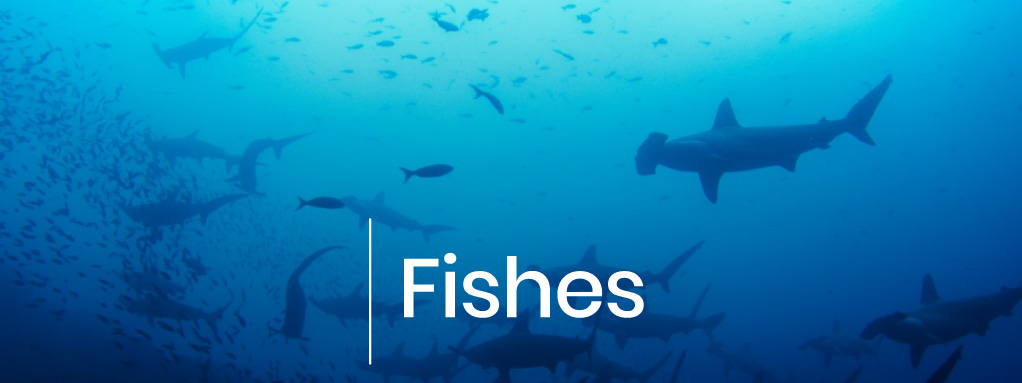
The Galapagos Islands are protected inside a 133,000 square kilometre Marine Reserve which is home to 2900 species, 25% of which are endemic. Because of the confluence of three different currents, the Galapagos waters are unusually rich in nutrients, and therefore, in life.
Read this section to find out about the gifts that evolution has left underwater for us to marvel at:

Hammerhead sharks are some of the most breathtaking fish and can be seen by snorkelers or divers (although not at the same distance or numbers). Adults can be quite large, growing up to six meters long. This is longer than an SUV! In addition to this and their iconic head shape, they are often seen swimming in schools, adding to the wow factor.
The impressive animals enjoy eating mackerels, stingrays, and other similar-sized fish. This happens in deeper waters, not coastal, and they usually roam at depths of at least 3 m/10 ft. Despite being bulky and fierce hunters, and thus potentially dangerous, very few attacks on humans have ever been recorded. Trained guides know how to tell when they are unsettled, so snorkelers and divers will always be relatively safe swimming with them. Most often they will be swimming without paying much attention to humans, thus making this a life-changing experience!

Whale sharks are truly impressive creatures. Not only are they the largest fish in the world, but also the largest shark to ever exist. Even bigger than the extinct megalodon! It is common to see individuals up to 18 m/59 ft and weigh around 20 tons.
Despite their impressive bus-like size, they are gentle giants and are harmless to humans. They are filter feeders and mostly eat plankton, krill, fish and coral eggs, and other small marine creatures.
A truly enigmatic fact about whale sharks is that they can only be found at Darwin’s Arch, and almost all of the sharks found are pregnant females (very few are male). This is a mystery biologists are actively working on finding the answer.

Although most rays are carnivorous, manta rays (the two species: reef manta ray and giant oceanic manta ray) are filter feeders. They swim with their mouths open, collecting zooplankton (close to the surface) and it is also thought that a good portion of their diet comes from mesopelagic sources.
These animals are a big highlight of any Galapagos tour, although they can usually only be seen near Cape Marshall (Isabela), Wolf and Darwin islands, and the channel between Santiago and Sombrero Chino. The likelihood of seeing them tends to go in hand with the increase in food brought by the seasonal currents.
Both species can be quite large (the oceanic manta, the largest of the two, can reach up to 7 m of width, making any encounter with them a spectacular moment. Additionally, mantas are frequently seen jumping and making all kinds of aerial acrobatics! The reasons for this behaviour are not known, but regardless of the possible explanation, it is spectacular behaviour nonetheless.

Opposite to mantas, rays are carnivorous and have very interesting adaptations. They have flat round bodies and, instead of moving side to side to swim, flap their fins up and down, creating an interesting undulating motion. They can also feel the electrical fields of other animals, which helps them avoid predators and catch their usual prey: small fish, mollusks, worms, squids, and more.
Some species, like spotted eagle rays and stingrays, have an iconic tail with a stinger. They don’t use this as a weapon to hunt but as a defensive one. Interestingly, they don’t store the venom in a gland but in their cell tissues. They strike by whipping up with their tail, lacerating with the stinger, causing a wound, and injecting the venom. However, all guides know how to move safely in locations with rays, and they always prefer to swim away than to strike.

These are the most common sharks in the archipelago and you can see them in abundance in reef areas. They are very docile and curious and are perfect for people that want to snorkel with sharks. It is common that they approach swimmers, just to check them out. These sharks can also be commonly spotted from land, in areas with shallow water.
Although you can see them in abundance in the Galapagos, they are categorized as vulnerable. Their populations have been declining rapidly outside of the Galapagos because they live in shallow waters of restricted habitats, and fisheries can easily catch them using longlines, trawls, and gillnets. These practices have increased in the last few years, especially in places where fishing practices are not well regulated.

Sunfish is the world’s largest bony fish, and also one of the most underrated. Large specimens can reach 14 feet vertically and 10 feet horizontally, and weigh nearly 5,000 pounds. This is impressive given their relatively limited diet of Jellyfish. Because of this last aspect, they have become rather instrumental in preserving the ocean’s balance of species. Warmer ocean temperatures have caused an unwanted increase in Jellyfish populations, so Sunfish help control their numbers.
You may think the Sunfish name has something to do with their unique round shape, but it’s actually related to their habit of basking in the sun near the surface. They do this to invite birds to feed off their parasites, and also to regulate their temperature and recharge, as they are known to skillfully navigate vertically to the colder sea bottoms.
No other creature considers Sunfish as food, but sea lions have been observed playing with their fins and even chewing them off. As innocent as Sunfishes are, they are also curious, so don’t be surprised if one approaches you while you’re underwater.

